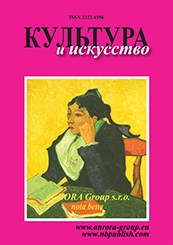Cultural heritage, tradition and innovation
Reference:
nikiforova, s.v., Pokatilova, I.V., Kharlampieva, N.R. (2019). Nomadic singularities of the contemporary art of Yakutia. Culture and Art, 11, 1Ц8. https://doi.org/10.7256/2454-0625.2019.11.31431
Abstract:
The relevance of the study is due to the fact that museum and exhibition activities in the region are not sufficiently diverse. Rare precedents of modern practices of contemporary art of Yakutia in the media hype, do not become the object of scientific research. The purpose of the proposed study is to consider the specifics of the organization of the exhibition space (2013), which has become a platform producing new meanings and forms of symbols of the traditional culture of Sakha (Yakuts). The subject of the study is the specifics of building a cultural text in the exhibition space, which allows practitioners of contemporary art to initiate artist-viewer interaction. The analysis of the reception of the inclusion of signs of traditional culture in the modern environment is proposed. The nomadology strategy chosen by the curators allows artists and viewers to transform the structural orderliness of traditional forms of culture into a nomadism unfolding before their eyes. The novelty of the research lies in the fact that contemporary art in the region is taking its first steps and has not yet become the subject of research. For the first time, the postmodern methodology is used on the material of contemporary Yakut art. We have considered one aspect of the exhibition "Prelude to Siberia" - the organization of the exhibition space as an unpredictable unfolding of a nomadic singularity and a provocative clash of traditional and postmodern discourse in regional culture.
Keywords:
sign, traditional culture, creative potential, singularity, cultural space, rhizome, nomadology, current art, communication, organization of space
Question at hand
Reference:
Tokoeva, G.T. (2019). Main trends in the development of Kyrgyz cinematography. Culture and Art, 11, 9Ц16. https://doi.org/10.7256/2454-0625.2019.11.30832
Abstract:
The subject of this article is a review of the development of cinematography in the Kyrgyz Republic from the beginning of 2000’s to the present. The arrival to mass digital technologies marked the emergence of the various film genres, transition from the “routinization” towards perfection of the auteur’s art. The main goal consists in examination of the main trends in development of the modern Kyrgyz cinematography using the historical-culturological analysis of artwork and interpretation of the content of modern national narrative films with the detailed description of storylines. The following screen works of the prominent film directors found their audience and recognition: “Ayil Okmotu” (The Village Authoritieis), “Boz Salkyn” (Pure Coolness), “Svet Ake” (The Light Thief) by Aktan Abdykalykov; “Everything is OK” by Akzhol Bekbolotov; “Kurmanjan Datka” (Queen of the Mountains) by Sadyk Sher-Niyaz; “Sayakbay “ by Ernest Abdyzhaparov. The author determines the development trends of the modern Kyrgyz cinematography, such as appearance of the tinsel cinema, “routinization” of films in the early 2000’s, development of short films, occurrence of the theme of self-identification. The analysis of their peculiarities defines the scientific novelty of the article.
Keywords:
author's cinema, self-identification in films, domesticization, non-conformist cinema, popular culture, directing, domestic cinematography, commercial cinema, author's art, short footage
Question at hand
Reference:
Moskovskaya, A.S. (2019). Image of the villain in the film by Lars von Trier УThe House That Jack BuiltФ. Culture and Art, 11, 17Ц29. https://doi.org/10.7256/2454-0625.2019.11.31127
Abstract:
The subject of this research is the main character of the Lars von Trier’s film “The House That Jack Built”. The author reconstructs in detail the image of the lead character Jack, reveals various traits of a villain in him, to see afterwards which of them Lars von Trier visualizes in his character. Based on the conducted analysis, the author offers the interpretation of the evil committed by Jack, as well as the image of the villain translated by Trier in his film. The modern villain becomes the central subject of research. The image of Jack was compared and verified leaning on the writings of Kant and Arendt. For the first time within the Russian research, the image of Jack is viewed in the context of the works of Kant and Arendt. It is suggested to consider him as an embodiment of kitsch. Jack reflects the mythology of Enlightenment, which manifested into the likeness of “Stalinism with a human face”, where everything can be reduced to numbers, where there is no death, and where blind order reigns disallowing outbursts of irrational and horrific.
Keywords:
Age of Enlightenment, violence, movie, ethics, Lars von Trier, Immanuil Kant, Hannna Arendt, evil, banality of evil, mind
Culture and Cult
Reference:
Rozin, V.M. (2019). The experience of humanistic study of esotericism . Culture and Art, 11, 30Ц44. https://doi.org/10.7256/2454-0625.2019.11.31586
Abstract:
In this article, the author summarizes his studies of esotericism, which contain the characteristics of the essence of esotericism, including analysis of a particular personality type as its source, as well as precise reconstructions of esoteric teachings determining the nature of that culture. The conducted reconstructions allowed specifying the peculiarities of esotericism, dividing it into mental and transcendental. Their analysis is provided. The author demonstrates the process of formation of esoteric outlook, and which role is assigned to the personality patterns and orientation. The specifics of esoteric reality and ways of its substantiation by esoteric experts. The author shares his thoughts on the boundaries of esotericism and its cultural role. As a result of the conducted research, the author was able to reconsider some of his previous works dedicated to esoteric teachings and esoteric personality. He introduces the definitions of the two types of esoteric teachings (mental and transcendental), explores the process of formation of esoteric outlook and personality, and raises the question on the limits and meaning of esotericism.
Keywords:
knowledge, culture, personality, science, reconstruction, scheme, reality, religion, esoterics, teaching
History of art
Reference:
Makeeva, S. (2019). Jackson Pollock and Allan Kaprow: figure of a painter at the turning point of modernism. Culture and Art, 11, 45Ц52. https://doi.org/10.7256/2454-0625.2019.11.31584
Abstract:
This article is dedicated to the two prominent figures in the art world of 1950’s-1960’s – abstract expressionist, representative of “painting of action” Jackson Pollock, and future generation painter, founder of the “environment” Allan Kaprow. On the grounds that the turn of the 1950’s-1960’s is viewed as a breakthrough era for the art of modernism, the article analyzes the artistic techniques of Pollock and Kaprow, as well as the social aspect of their work for determining the points of convergence and divergence in their practice. Critical and theoretical texts used in the article include the works of Clement Greenberg, Michael Fried, Yve-Alain Bois, and Allan Kaprow himself, who is known not only as a painter, but also as theoretician of the new artistic practices of 1960’s – assemblage, environment and happening. The focus of author’s attention became the insufficiently studied and untranslated into the Russian language text of Allan Kaprow “Legacy of Jackson Pollock” (1958), which defines the scientific novelty of this research. Within the framework of modernistic discourse, the works of Jackson Pollock are viewed as a pinnacle of “self-purification” of the avant-garde painting and realization of the principle of medium-specificity. However, some aspects played a significant role for artistic practices of the 1960’s, longing to cut ties with abstract expressionism. Reference to such aspects – performativity of Pollock’s painting, his representation on the graphic form, format and spatial dimension of his canvasses – allows determining continuity between the opposing trends of art of the 1950’s-1960’s, and reveal the role of Jackson Pollock as a crucial transitional figure at the turning point of modernism.
Keywords:
action painting, medium, Minimalism, environment, painting, Modernism, avant-garde, Abstract Expressionism, dripping, authorship
 This work is licensed under a Creative Commons Attribution-NonCommercial 4.0 International License.
This work is licensed under a Creative Commons Attribution-NonCommercial 4.0 International License.
 Eng
Eng












 © 1998 Ц 2025 Nota Bene. Publishing Technologies. NB-Media Ltd.
© 1998 Ц 2025 Nota Bene. Publishing Technologies. NB-Media Ltd.




